

Notre mission: vous aider à créer plus d'impact dans la société. Switching Costs: 6 Ways To Lock Customers Into Your Ecosystem. 1.
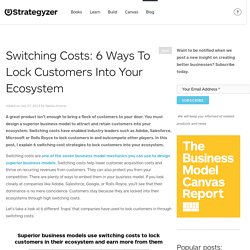
‘Base Product & Consumable trap’: Nespresso, Gillette, HP, Kodak For this trap, companies lure customers into their ecosystem with a base product and then milk profits from 'consumables' that customers are forced to buy. Nespresso coffee machines (base product) are sold at cost and available at major retailers so anyone can buy them. But the highly-profitable coffee pods are only sold through Nespresso’s owned sales channels, allowing them to absorb juicy margins. There was no way to buy pods from another manufacturer until 2011 because Nespresso owned exclusive rights to produce them. 2.
The ‘Data trap’ consists encourages customers to create or purchase content and apps that are exclusively hosted on a platform. 3. Customers can be discouraged when they have to start over and learn how to use a new product. 4. Sometimes, you are forced to do things because everyone else does it a certain way. 5. 6. Related Posts. 3 Reasons Why A Turnaround Plan Won’t Save McDonald’s. For decades, McDonald’s value pitch has been that customers can enjoy a quick and inexpensive meal.
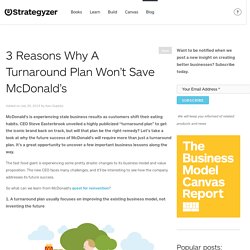
These days, fast and cheap is often associated with low quality; it’s a tough perception to shake when your products are so cheap. Customers now value an emphasis on healthy eating, fresh products, and a customized experience. That’s a tough sell for a company that’s made its mark through cookie-cutter value meals. Customers who want quality, that includes better burgers, have plenty of other options to choose from. Core customers aren’t interested in premium items when they can still buy the cheaper options. Food for thought: Always be aware of your customers’ shifting priorities. 3. What Is a Business Model? In The New, New Thing, Michael Lewis refers to the phrase business model as “a term of art.”
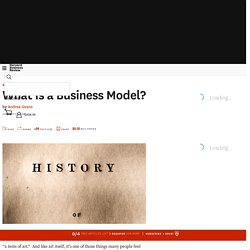
And like art itself, it’s one of those things many people feel they can recognize when they see it (especially a particularly clever or terrible one) but can’t quite define. That’s less surprising than it seems because how people define the term really depends on how they’re using it. Lewis, for example, offers up the simplest of definitions — “All it really meant was how you planned to make money” — to make a simple point about the dot.com bubble, obvious now, but fairly prescient when he was writing at its height, in the fall of 1999.
Paywall mobile. Don't Build When You Build-Measure-Learn. Wizard of Oz To run a "Wizard of Oz" MVP, set up a front stage that mimics a real, working value proposition.
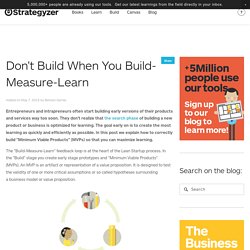
On the back-end you will manually carry out the tasks of what would normally be a more automated process for delivering your value proposition. *Check out our new book Value Proposition Design for deeper understanding of how to create these MVPs. Choosing Your MVP Build-Measure-Learn is sequential to how you carry out the actions in the search phase.
3 Ways Color-Coding Can Improve Story-Telling In Your Business Model Canvas. Application: Emphasize the inner-workings of your business model by building a color-code based on one of the building blocks.
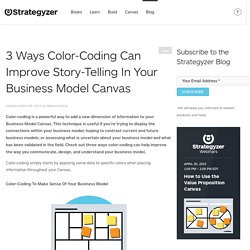
Apply it to all the elements that relate to it in the Canvas (e.g. a color applied to different types of customer segments and elements connected to them). The visual image you get reveals the underlying dynamics of your Canvas: in the illustration below we show some of the dynamics of Google's bare-bones business model. In the color-coded version you can immediately see which building blocks relate to users/searchers, which building blocks relate to advertisers and which ones to both. The color-coded version more clearly reveals the platform aspect of Google's business model with relies on two very different customer segments.
Yan Thoinet sur Twitter : "Startups -> Pitching investors sur la base du BMC #businessmodel canvas #storytelling Pitch. Ep 6 – Telling Your Story – Pitching to investors. Le business model d'une application mobile gratuite. Avec cet article sur le business model d’une application mobile gratuite, nous poursuivons une série estivale sur les stratégies de monétisation les plus courantes pour les startups du numérique.
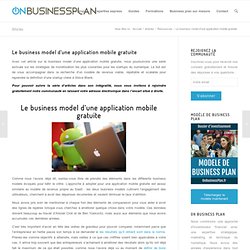
Le but est de vous accompagner dans la recherche d’un modèle de revenus viable, répétable et scalable pour reprendre la définition d’une startup chère à Steve Blank. Pour pouvoir suivre la série d’articles dans son intégralité, nous vous invitons à rejoindre gratuitement notre communauté en laissant votre adresse électronique dans l’encart situé à droite. Comme nous l’avons déjà dit, sentez-vous libre de prendre des éléments dans les différents business models évoqués pour bâtir le vôtre. L’approche à adopter pour une application mobile gratuite est assez similaire au modèle de revenus propre au SaaS : les deux business models cultivent l’engagement des utilisateurs, cherchent à avoir des dépenses récurrentes et veulent diminuer le taux d’attrition. The Money Making Techniques every startup should know (by @boardofi... Osez-l-innovation.pdf.